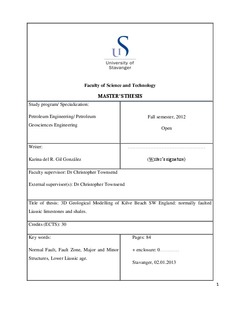| dc.description.abstract | This study is based on the outcrops examples on Kilve Beach area, which is the onshore continuation of the Bristol Channel Basin, South of England, U.K. Kilve is a fault zone going into Lower Jurassic age limestones and mudrocks. The faults are well exposed on the Limestone bedding and related with the development of the Bristol Channel Basin during the Mesozoic (Beach, 1989). None of the Faults described on this project have showed evidence of strike-slip or reverse-reactivation that occurred in the Bristol Channel during the Tertiary (Beach, 1989).
The interpretation and understanding of the faults & horizons geometries are based on measurements, photographs, maps and GPS data taken on the field.
The localities were divided in three (Kilve Pill, Major fault 1 (Syncline 1) and After Red House or Major Fault 2 (Syncline 2)) in order to make a small scale interpretation due to the quality of the exposure. Two master faults have been identified as Normal presenting E-W striking with dip variable depending on the localities.
The three localities studied were dominated by E-W striking normal faults. The beddings exposed on the beach and cliff section consist of limestone and organic-rich shale interbedded. In general the dipping of these beddings was towards to the South-west.
The stratigraphic sequences and structural data were measured in the area and loaded in the Petrel ™ software to build a 3D geological model. 18 faults were interpreted on the outcrops, only 11 faults were included in the model (excluding the small reverse faults and those exposed only in the cliff section). The results show a good matching between the faults and horizons in the photographs digitized, also with the interpretations done in the field. The normal and reverse faults and horizons presented the same behaviour as well as those which were interpreted previously.
In addition, facies (i.e. sand and shale), petrophysical (i.e. porosity) and fluid properties (i.e. water saturation) were generated to get the volume calculations.
The structural model built in this study, may be used to improve the understanding of the large number of fields in the North Sea, which its developments are linked to the fault behaviour. | no_NO |
